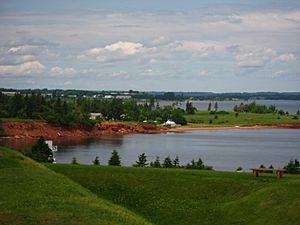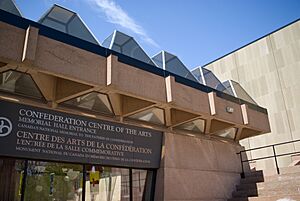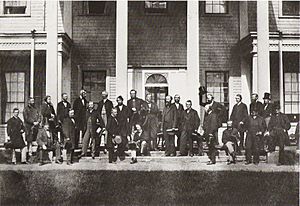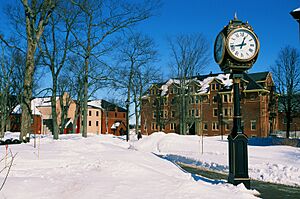History of Charlottetown facts for kids
Welcome to the exciting history of Charlottetown! This city, the biggest and most important on Prince Edward Island, has a long story. It all started with a French military settlement way back in 1720. Over the years, Charlottetown has grown into the vibrant capital it is today.
Contents
Charlottetown's Early Days: The 1700s

The very first European settlers in this area were French. In 1720, people from Fortress Louisbourg started a settlement called Port-la-Joye. It was located across the harbour from where Charlottetown is now. Michel Haché-Gallant led this settlement. He used his boat to bring Acadian settlers from Louisbourg.
During a conflict called King George's War, the British took control of the island. A French officer, Jean-Baptiste Nicolas Roch de Ramezay, sent 500 men to fight the British. In the Battle at Port-la-Joye, the French won, capturing or killing forty British soldiers.
In August 1758, during the Seven Years' War, a British fleet took over the settlement. They also took control of the rest of the island. The British quickly sent away the French settlers they found. This happened three years after the main Acadian Expulsion in Nova Scotia. British forces then built Fort Amherst. It was near the old Port-la-Joye site. This fort helped protect the entrance to the harbour.
Becoming the Capital City
In 1764, Captain Samuel Holland of the Royal Engineers surveyed the area. He chose Charlottetown to be the main town for Queens County. Just one year later, Charlottetown became the capital of St. John's Island. More surveys between 1768 and 1771 created the street layout we still see today. The town was named after Queen Charlotte of Mecklenburg-Strelitz. She was the wife of King George III.
On November 17, 1775, during the American Revolutionary War, American privateers attacked the new capital. They stole the colony's official seal. They also took some important people, like Phillips Callbeck, as prisoners. These prisoners were taken to Cambridge, Massachusetts, but were later set free.
In 1793, Governor Fanning set aside land for the Governor's use. People called it "Fanning's Bank." On November 29, 1798, St. John's Island got a new name. It was renamed Prince Edward Island to honor Prince Edward, Duke of Kent and Strathearn. He was a top military leader in North America.
Charlottetown in the 1800s: Growth and Confederation
In 1805, the British soldiers built a harbor defense called "Fort Edward." It was west of the capital's waterfront. The "Prince Edward Battery" operated this fort.
In 1835, a grand building called "Government House" was built at Fanning Bank. It was meant to be the home for the colony's Governor. Today, it is still the official residence for the Lieutenant Governor.
Between 1843 and 1847, a new legislative building was constructed. It was named "Province House." Finishing this building was a big moment for the capital. It is still used today as the provincial legislature. It is also the second-oldest legislative building in Canada.
On April 17, 1855, Charlottetown officially became a city. Its first city council meeting happened on August 11 that year. At the time, about 6,500 people lived in the community.
From September 1 to September 7, 1864, Charlottetown hosted a very important meeting. It is now known as the Charlottetown Conference. This conference was where leaders discussed creating Canadian Confederation. Many meetings happened in Province House. But social events also took place all around the city.
On June 14, 1873, the land at Fanning Bank became a public park. It was named Victoria Park to honor Queen Victoria. Prince Edward Island officially joined Confederation on July 1, 1873.
Besides being the government center, Charlottetown was known for other things. In the early 1800s, it was important for shipbuilding and the lumber industry. It was also a busy fishing port. The shipbuilding industry slowed down in the late 1800s. In August 1874, the Prince Edward Island Railway opened. Its main line connected Charlottetown and Summerside. The railway and shipping continued to help industries grow along the waterfront for many years.
The first hospital in the province, the Charlottetown Hospital, opened in 1879. It was started by the Diocese of Charlottetown. Then, the publicly run Prince Edward Island Hospital opened in 1884. In 1885, Charlottetown's status was upgraded again, confirming it as a city.
Charlottetown in the 1900s: Modern Growth and Changes

Religion played a big role in how Charlottetown's public services developed. There were separate schools and hospitals for different religious groups. For example, there were Catholic public schools and Protestant ones. There were also different hospitals and colleges. St. Dunstan's University was originally a seminary for training priests. Maritime Christian College was founded in 1960 to train preachers.
Like many places, the automobile changed Charlottetown a lot in the second half of the 1900s. Farms in areas like Brighton and Spring Park became places for new houses.
The Charlottetown airfield, near Sherwood, was improved during the British Commonwealth Air Training Plan. It was used as RCAF Station Charlottetown during World War II. After the war, it became Charlottetown Airport. Charlottetown's shipyards were also very busy during World War II. They were used to fix and upgrade many Royal Canadian Navy warships. After the war, more homes were built in nearby farming areas like Sherwood and West Royalty.

In 1959, the village of Spring Park joined the city. This made the city bigger, reaching Hermitage Creek. It also included the campus of St. Dunstan's University.
To celebrate 100 years since the Charlottetown Conference, Canada's governments built a national monument. The Confederation Centre of the Arts opened in 1964. It was a gift to the people of Prince Edward Island. The center has an art gallery, a public library, and a main theatre. The Charlottetown Festival has been held there every summer since.
In the 1960s, new public schools were built. In 1969, Charlottetown became home to the new University of Prince Edward Island (UPEI). It was created by combining smaller colleges. UPEI is located on the old St. Dunstan's University campus. Along with the federal Department of Agriculture and Agri-Food's farm, these areas create a large green space in the city. The downtown campus of Prince of Wales College became part of a new college system. It was named Holland College, honoring the island's famous surveyor.
The Queen Elizabeth Hospital opened in 1982. In 1983, the national office for Veterans Affairs Canada moved to Charlottetown. This was part of a plan to spread government jobs across the country. In 1986, UPEI grew more with the opening of the Atlantic Veterinary College.
Throughout the 1970s and 1980s, Charlottetown saw more office and shopping buildings. A hotel and convention center opened in 1982. This helped bring new businesses and life to the waterfront. It led to new homes and downtown shops. In December 1989, CN Rail stopped train service on the island. The old railway lands along the waterfront were turned into parks and cultural spots.
In the late 1990s and 2000s, shopping changed. Large "big box" stores opened where old shopping centers used to be. New stores also appeared in the northern suburbs, especially in West Royalty.
In 1995, Charlottetown became much larger. It merged with several nearby communities. These included Sherwood, Parkdale, Winsloe, West Royalty, and East Royalty. Now, the city covers most of Queens Royalty.
The main business area continues to grow. New government and private offices are built. But downtown shops have faced challenges because of the big box stores outside the city center.
See also




